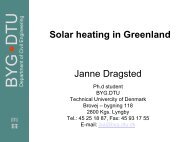1 OMAE01-PIPE4030 ABSTRACT The magnitudes of pipeline - Artek
1 OMAE01-PIPE4030 ABSTRACT The magnitudes of pipeline - Artek
1 OMAE01-PIPE4030 ABSTRACT The magnitudes of pipeline - Artek
Create successful ePaper yourself
Turn your PDF publications into a flip-book with our unique Google optimized e-Paper software.
<strong>The</strong> physical processes governing liquefaction<br />
due to residual pore pressure build-up are<br />
similar to the processes causing earthquakeinduced<br />
liquefaction. So it is a balance<br />
between the rate <strong>of</strong> pore pressure generation in<br />
the soil, which in turn is related to the<br />
magnitude <strong>of</strong> the cyclic shear stress ratio,<br />
CSSR = τxz/σv’, and the rate <strong>of</strong> dissipation <strong>of</strong><br />
pore pressure. <strong>The</strong> CSSR at the seabed<br />
surface is given as (Seed and Rahman, 1978)<br />
k<br />
CSSR ( Z = 0)<br />
= p0<br />
= S(<br />
1 + e)<br />
(31)<br />
gρ′<br />
Earthquake induced liquefaction has been<br />
observed in the range <strong>of</strong> CSSR values <strong>of</strong> 0.1 to<br />
0.3 and since the mechanism <strong>of</strong> earthquakeand<br />
wave-induced residual pore pressure<br />
liquefaction are similar, this is also an<br />
appropriate range <strong>of</strong> CSSR values for the<br />
present problem. For the one-dimensional<br />
situation CSSR decays with depth as exp(-kz).<br />
<strong>The</strong> expected range <strong>of</strong> Scr values for initiation<br />
<strong>of</strong> residual liquefaction is shown on Figure 2.<br />
4. PIPELINE ENGINEERING<br />
IMPLICATIONS<br />
A number <strong>of</strong> conclusions can be drawn from<br />
the preceding analyses:<br />
1) for all realistic field conditions a<br />
sandy seabed will become mobile at<br />
forcing levels significantly lower<br />
than those required to mobilise a<br />
<strong>pipeline</strong>,<br />
2) marginal <strong>pipeline</strong> stability can under<br />
realistic field conditions be<br />
accompanied by seabed liquefaction,<br />
which, in turn, is likely to result in<br />
sinking <strong>of</strong> the <strong>pipeline</strong>, at least for<br />
typical values <strong>of</strong> pipe specific<br />
gravity,<br />
3) there are conditions for which the<br />
two different types <strong>of</strong> liquefaction<br />
could theoretically coexist.<br />
In terms <strong>of</strong> subsea <strong>pipeline</strong> engineering the<br />
consequence is that the traditional methods for<br />
assessing on-bottom stability are based on an<br />
8<br />
unrealistic physical concept, namely that <strong>of</strong> a<br />
<strong>pipeline</strong> resting on a hard, or at least<br />
immobile, surface. A more realistic situation<br />
during extreme conditions is a static <strong>pipeline</strong><br />
resting on a seabed at which the sediment is<br />
mobile. This is also sometimes referred to as a<br />
‘live scour’. Consider that the presence <strong>of</strong> the<br />
pipe will cause local amplification <strong>of</strong> the<br />
velocity and the bed shear-stress. It is then<br />
clear that the sediment transport near the pipe<br />
will be even higher than the transport<br />
occurring further away from the pipe. <strong>The</strong><br />
potentially high sediment transport rates<br />
associated with marginal pipe stability will<br />
have two contradictory effects: <strong>The</strong> scour<br />
around and under the pipe will result in a<br />
certain amount <strong>of</strong> self-burial and increased<br />
stability against horizontal movement. On the<br />
other hand the sediment laden near bed flow<br />
will effectively increase the ‘fluid’ density and<br />
consequently the hydrodynamic forces on the<br />
<strong>pipeline</strong>.<br />
<strong>The</strong> fact that seabed liquefaction or failure can<br />
occur near the design conditions implies that a<br />
<strong>pipeline</strong> with a specific gravity <strong>of</strong>, say, 1.4 to<br />
1.6 can sink into the soil before horizontal<br />
instability is reached. If that happens the<br />
resistance to horizontal movement will<br />
increase with increasing embedment (see e.g.<br />
Damgaard et al., 1999). <strong>The</strong> continued<br />
oscillatory motion <strong>of</strong> the pipe itself will<br />
interact with the mobile seabed and exacerbate<br />
the self-burial process. Depending on subsurface<br />
soil conditions, the pipe may bury<br />
entirely.<br />
<strong>The</strong> typical engineering action taken to<br />
achieve on-bottom stability is to design the<br />
pipe concrete coating in accordance with the<br />
traditional stability criteria. <strong>The</strong> present<br />
findings show that conventional methods may<br />
lead to over-design. <strong>The</strong>re is a need to<br />
investigate these issues further to reach new<br />
recommended guidelines that take account <strong>of</strong><br />
seabed dynamics<br />
ACKNOWLEDGEMENTS<br />
<strong>The</strong> funding for this work was provided by the<br />
Commision <strong>of</strong> the European Communities<br />
Directorate General for Science, Research and<br />
Development as a part <strong>of</strong> the LIMAS<br />
collaborative research programme, under the





